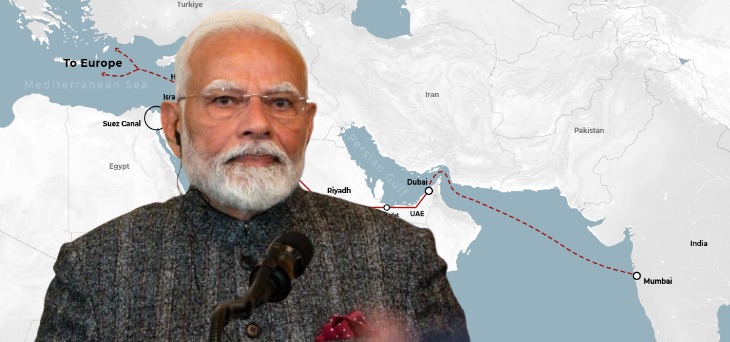By Mirza Abdul Aleem Baig
Amidst the new global disorder, India has emerged as the world’s fifth-largest economy and projected to become the third by 2027, solidifying its position as a rising global power. This economic ascent has enabled New Delhi to project influence on the international stage, engaging in strategic partnerships and asserting its leadership in multilateral forums.

However, despite its growing global stature, India faces a complex web of domestic political and economic challenges that could hinder its progress. At the same time, China’s geopolitical and economic maneuvers present both challenges and opportunities for India, particularly in the Global South and Indo-Pacific region.
India’s foreign policy has long been defined by a strategic autonomy that seeks to balance its relationships with major global powers. In the contemporary geopolitical landscape, New Delhi aims to be a key ally of the United States while maintaining a degree of strategic independence from Washington.
This delicate balancing act is evident in India’s engagement with the Quadrilateral Security Dialogue (QUAD) alongside the U.S., Japan, and Australia, while simultaneously fostering strong ties with Russia and maintaining a cautious stance on China.
India’s role in BRICS+ and the Shanghai Cooperation Organization (SCO) underscores its commitment to a multipolar world order, resisting alignment with any single superpower.
Over and above, New Delhi’s participation in regional and global economic frameworks, such as the Indo-Pacific Economic Framework (IPEF) and free trade agreements with countries across Asia and Europe, reflects its ambition to expand its economic and strategic footprint.
China’s rise as an economic and military superpower has created a range of strategic challenges for India. The border disputes, particularly along the Line of Actual Control (LAC), have led to frequent military standoffs, undermining trust between the two nations.
Into the bargain, Beijing’s influence in South Asia, through infrastructure investments in Pakistan, Sri Lanka, Nepal, and Bangladesh under the Belt and Road Initiative (BRI), has raised concerns about India’s regional security and economic interests.
China’s increasing presence in the Indian Ocean – Maritime Silk Road, including military bases and deep-water ports, poses a direct challenge to India’s maritime dominance. What’s more, Beijing’s aggressive technological and economic diplomacy, including its leadership in global supply chains, advanced manufacturing, and digital infrastructure, requires India to accelerate its own technological and industrial capabilities to remain competitive.
In response to China’s expansive Belt and Road Initiative (BRI), India, along with its strategic partners, has backed the India-Middle East-Europe Economic Corridor (IMEC). Announced at the G20 Summit, IMEC is a transformative infrastructure project designed to enhance connectivity between India, the Middle East, and Europe.
The initiative is expected as a direct counter to China’s BRI by offering an alternative trade route that prioritizes transparency, sustainability, and economic sovereignty. IMEC consists of two key corridors; the Eastern Corridor, connecting India to the Middle East, and the Northern Corridor, linking the Middle East to Europe. This multi-modal transport initiative includes a combination of rail and maritime networks, facilitating the efficient movement of goods, energy, and digital infrastructure across continents.
IMEC presents several strategic advantages over BRI, which has been widely criticized for creating debt dependency in participating nations. Unlike China’s BRI, which has faced allegations of debt-trap diplomacy by extending unsustainable loans to weaker economies, IMEC emphasizes financial sustainability and fair investment practices.
The corridor will significantly reduce trade transit times between India and Europe, providing an alternative to traditional sea routes that pass through congested chokepoints such as the Suez Canal. Additionally, IMEC strengthens India’s economic and political ties with Middle Eastern nations, including the UAE and Saudi Arabia, while bolstering connectivity with Europe, particularly with major economies like Germany and France.
The initiative will also facilitate the export of green energy and digital services, positioning India as a key player in the global renewable energy and technology sectors. While IMEC presents a significant opportunity for India and its allies, it faces challenges such as securing long-term financing, navigating geopolitical tensions in the Middle East, and ensuring efficient coordination among multiple stakeholders.
Nevertheless, IMEC represents India’s commitment to creating an alternative global trade and infrastructure ecosystem that limits China’s economic leverage. While India’s economic rise is impressive, significant structural issues persist. Despite robust GDP growth, challenges such as unemployment, income inequality, and infrastructural bottlenecks continue to impede equitable development.
The informal sector remains dominant, and while initiatives like “Make in India” and “Production-Linked Incentive (PLI)” aim to boost manufacturing and domestic production, their long-term success is yet to be fully realized. Additionally, India faces issues related to financial inclusion, banking sector vulnerabilities, and inflationary pressures, which can undermine macroeconomic stability.
The government’s push for digital transformation and technological advancements, including initiatives like “Digital India” and the expansion of fintech solutions, aims to modernize the economy and enhance productivity. However, bridging the gap between high economic growth and equitable distribution of wealth remains a pressing challenge.
On the domestic front, India is witnessing a shift toward an increasingly illiberal, majoritarian form of democracy. Political centralization, the suppression of dissent, and challenges to press freedom have raised concerns among observers of India’s democratic trajectory. Electoral victories have solidified the dominance of the ruling party, enabling policy decisions that cater to majoritarian sentiments while sidelining minority voices.
Religious and ethnic divisions have been exacerbated by identity politics, with policies and laws often viewed through the lens of sectarian interests such as The Waqf Bill. The erosion of institutional independence, judicial interference, and constraints on civil liberties contribute to growing anxieties about the future of democratic governance in India.
This trend poses a dilemma for India’s global image as a democratic leader, as concerns about human rights and religious freedoms could affect its diplomatic standing and trade negotiations with Western partners.
India’s aspirations to be a global power are contingent upon its ability to navigate both external and internal challenges. Strengthening economic reforms, fostering inclusive growth, and upholding democratic values will be critical in ensuring that India’s rise is sustainable and beneficial for all its citizens. On the global stage, New Delhi’s ability to maintain strategic autonomy while deepening alliances will determine its effectiveness as a major player in international politics.
As India moves forward, the choices it makes in balancing economic growth, democratic principles, and geopolitical strategy will shape its trajectory for decades to come. At the same time, managing its complex relationship with China while leveraging initiatives like IMEC to counter Beijing’s influence will be key to securing India’s long-term economic and strategic interests.
Author: Mirza Abdul Aleem Baig – President of Strategic Science Advisory Council (SSAC) – Pakistan. He is an independent observer of global dynamics, with a deep interest in the intricate working of techno-geopolitics, exploring how science & technology, international relations, foreign policy and strategic alliances shape the emerging world order.
(The views expressed in this article belong only to the author and do not necessarily reflect the views of World Geostrategic Insights).







